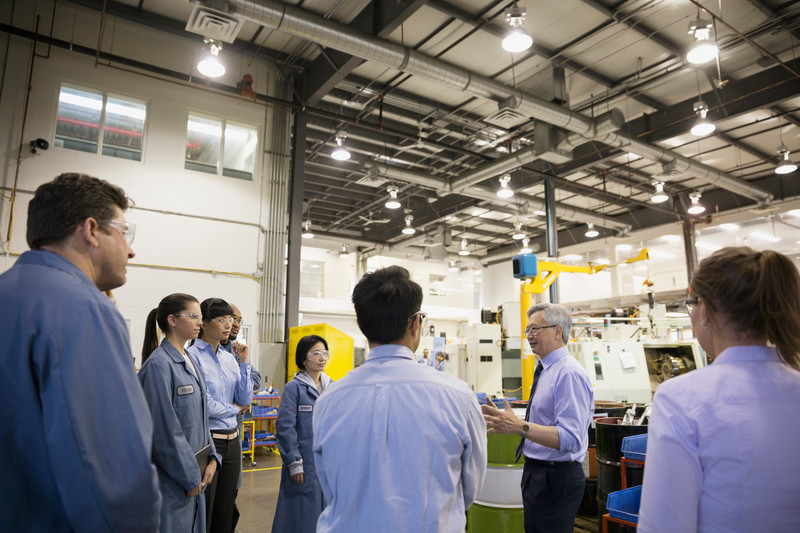Internet of Things
The Manufacturing Side of Digital Transformation: Smart Factories
March 4, 2019 | Written by: Patrick Murphy
Categorized: AI | Analytics | Data Visualization | Internet of Things | IoT
Share this post:
 The fourth Industrial Revolution, often called Industry 4.0, is now underway. This is the manufacturing side of digital transformation — the tantalizing potential of “smart factories” that deliver intelligence on demand.
The fourth Industrial Revolution, often called Industry 4.0, is now underway. This is the manufacturing side of digital transformation — the tantalizing potential of “smart factories” that deliver intelligence on demand.
The evolution of data-driven autonomous systems and machine learning tools underpins the promise of Industry 4.0 as organizations look to connect IoT devices, collect critical metrics, visualize data in real time, analyze results and optimize manufacturing processes.
But there’s a caveat: While typical factories now generate one terabyte of production data each day, 90+ percent of this data isn’t properly utilized. How do manufacturers leverage existing resources, implement new solutions and revolutionize factory-floor intelligence?
With the Industrial Internet of Things (IIoT) upon us, technologies such as robotics, 3D printing, advanced analytics and AI now offer the potential for connected, additive and autonomous manufacturing processes — which is critical for companies looking to extend the lifespan of machines, reduce device breakdowns and increase throughput.
The challenge is connection. Ask manufacturers about IoT and most will say they’ve been doing it for years leveraging networked “legacy” controller and sensors, such as PLCs and smart devices, and store data both local and within historians — but today it’s not enough, as many assets in the factory are in isolation. In order to meet IIC consortium standards, the smart factories of Industry 4.0 will need to deliver better device security, ease of connectivity and common platforms. By bridging the gap between legacy and transformative technologies, manufacturers can gain access to existing data sets and new data streams.
Before businesses can leverage large-scale production data, they need a reliable way to save, store, aggregate and cross-compare this information. The challenge of digital transformation is shifting from simple collection (which leaves 90+ percent of data in storage rather than used in-situ) to combined online and offline collection methods that empower organizations to take action based on real-time insights rather than just create reports.
Visualize Outcomes
Many factories struggle with the “blank screen” problem, too. When manufacturing processes and assets aren’t transparent, it leaves both asset operators and managers in the dark until products are shipped. The goal of Industry 4.0 is to enable informational dashboards that transform data into insights at the operator level.
Live metrics and tools to support quick and consistent decision-making can empower smart-factory operators, letting them run assets for business by filtering through the “noise” of production data to provide more relevant data and drive actionable insight.
Analyze Everything
Increasing familiarity with cloud technologies and connected devices has 78 percent of manufacturing organizations planning to increase their investment in IIoT, according to a study by BSquare. When it comes to analytics, however, many factories still rely on manual processes and Excel spreadsheets to determine asset availability, draft maintenance schedules or make critical decisions.
Why? Imagine a chemical plant with a critical sensor 500 feet away from the factory floor. Historically, a single employee checks the sensor once a day. Since the process isn’t broken, and “fixing” it would cost time and money to install and calibrate an IoT sensor, why make the change? Here, the business case for Industry 4.0 must be tied to a rational investment — a specific goal that boosts productivity or lowers failure rates.
Market research firm Aberdeen points to the compelling case for prescriptive analytics, using available data collected from IoT devices to determine the best course of action across multiple choices given the known parameters. In the previous example, this means spending on connected sensor technology to create insight-driven dashboards.
Optimize with Cognitive Computing
This is what manufacturers think of when they hear the term Industry 4.0: optimizing factory floor processes using cognitive computing technologies. In actuality, solutions such as IBM’s Watson for manufacturing can do much more. Deployed across environments with connected devices, continuously collected data sets, resource transparency and evolving analytics, Watson can help you drive a self-sustaining smart factory model.
Consider the emerging problem of skilled worker shortages. According to Industry Week, a combination of retiring workers and new job creation has created a problem: New personnel are frustrated by the lack of data on demand, and there’s a dwindling number of experts to share their “shop floor” knowledge.
By deploying technologies, like Watson, as organizations move through the first four stages of smart factory evolution, companies can gain a dual benefit. Cognitive solutions learn the unique processes that underpin critical assets, and employees trust in machine learning tools. The result is a continually expanding knowledge base informed by factory-specific behavior that can help you onboard new employees and drive prescriptive manufacturing strategies.
Industry 4.0 is changing the manufacturer journey, with digital transformation now forming the foundation of smart factories driven by intelligence on demand. Learn more on how to keep up with this new wave of connected manufacturing.
______________________________
Click here for a visual representation of the Digital Transformation Journey to becoming a Smart Factory.

Partner, IBM North American Practice Leader, Cognitive Manufacturing, Global Business Services
A New Wave: Transforming Our Understanding of Ocean Health
Humans have been plying the seas throughout history. But it wasn’t until the late 19th century that we began to truly study the ocean itself. An expedition in 1872 to 1876, by the Challenger, a converted Royal Navy gunship, traveled nearly 70,000 nautical miles and catalogued over 4,000 previously unknown species, building the foundations for modern […]
Igniting the Dynamic Workforce in Your Company
In the rapid push to moving to remote work, we’ve seen digital strategies accelerate by years – transforming their workplaces, workstyles, and business processes forever. Overnight, remote workforces put advanced environments of multi-device mobility, dynamic connection points and robust cloud-based apps that ease communication and collaboration. A new normal is emerging, led by the companies aggressively adopting cloud […]
Lessons from Space May Help Care for Those Living Through Social Isolation on Earth
Since the Crew Dragon spacecraft arrived at the International Space Station (ISS) on May 31, NASA astronauts Bob Behnken and Doug Hurley have been busy—according to their Twitter posts, even working over the weekend to repair the ISS treadmill. They likely don’t have much time to think about being lonely and cut off from life […]


